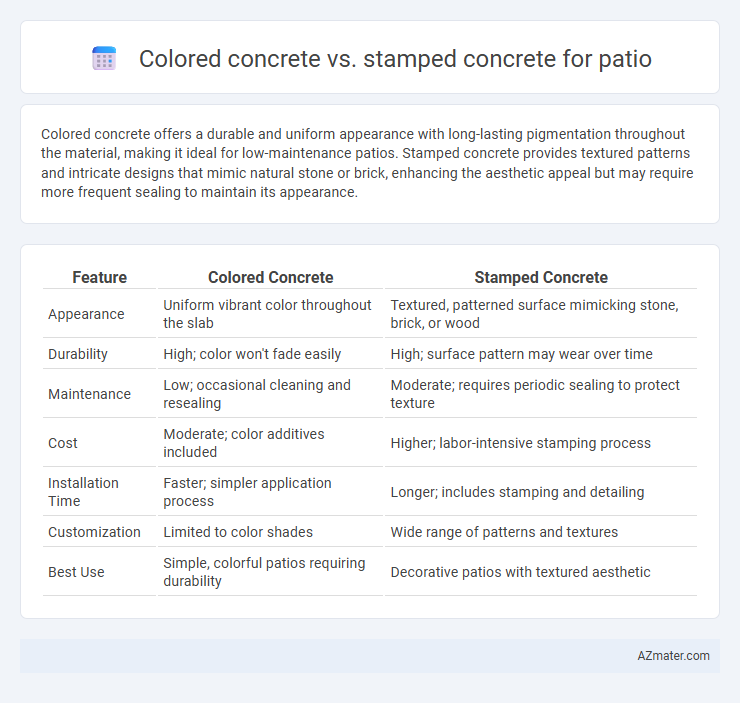Colored concrete offers a durable and uniform appearance with long-lasting pigmentation throughout the material, making it ideal for low-maintenance patios. Stamped concrete provides textured patterns and intricate designs that mimic natural stone or brick, enhancing the aesthetic appeal but may require more frequent sealing to maintain its appearance.
Table of Comparison
| Feature | Colored Concrete | Stamped Concrete |
|---|---|---|
| Appearance | Uniform vibrant color throughout the slab | Textured, patterned surface mimicking stone, brick, or wood |
| Durability | High; color won't fade easily | High; surface pattern may wear over time |
| Maintenance | Low; occasional cleaning and resealing | Moderate; requires periodic sealing to protect texture |
| Cost | Moderate; color additives included | Higher; labor-intensive stamping process |
| Installation Time | Faster; simpler application process | Longer; includes stamping and detailing |
| Customization | Limited to color shades | Wide range of patterns and textures |
| Best Use | Simple, colorful patios requiring durability | Decorative patios with textured aesthetic |
Introduction to Colored and Stamped Concrete Patios
Colored concrete patios offer vibrant hues infused throughout the mix, providing long-lasting color that resists fading and wear. Stamped concrete patios create textured patterns resembling natural materials such as stone, brick, or wood, adding depth and visual appeal. Both options enhance outdoor spaces with customizable aesthetics, durability, and low maintenance requirements.
What is Colored Concrete?
Colored concrete is a type of decorative concrete infused with pigments to create a uniform and vibrant hue throughout the entire mix, making it ideal for durable and visually appealing patio surfaces. This method ensures long-lasting color that won't fade or peel, enhancing outdoor aesthetics with a natural look that can be tailored to various design preferences. Compared to stamped concrete, colored concrete provides consistent coloration without surface coats, offering a strong, low-maintenance solution for patios.
What is Stamped Concrete?
Stamped concrete is a decorative concrete technique that involves imprinting patterns and textures onto freshly poured concrete to mimic materials like brick, stone, or wood, providing an elegant and customizable patio surface. It offers durable, slip-resistant qualities and a wide range of color options through integral pigments, making it ideal for enhancing outdoor aesthetics. Compared to colored concrete, stamped concrete combines both color and texture, delivering a more intricate and visually appealing patio finish.
Design Options: Patterns, Textures, and Colors
Colored concrete offers a wide range of design options with consistent, uniform hues suited for modern patios, allowing homeowners to customize vibrant or subtle shades to complement outdoor decor. Stamped concrete provides intricate patterns and textures that mimic natural materials such as stone, brick, or wood, delivering rustic and classic aesthetics with enhanced visual depth. Combining colored concrete with stamping techniques enriches patios by blending rich colors with detailed textures, maximizing design versatility for tailored outdoor spaces.
Durability and Maintenance Comparison
Colored concrete offers superior durability due to its integral pigments that penetrate the concrete, resisting fading and chipping over time. Stamped concrete, while visually appealing with its textured patterns, can be more susceptible to wear and surface cracking, requiring regular resealing to maintain its appearance. Maintenance for colored concrete is generally lower, involving simple cleaning and occasional sealing, whereas stamped concrete demands frequent upkeep to prevent damage and preserve its decorative finish.
Cost Differences: Installation and Long-term Value
Colored concrete typically costs between $4 to $8 per square foot for installation, offering a straightforward and cost-effective solution for patios with long-lasting durability and minimal maintenance. Stamped concrete installation ranges from $8 to $15 per square foot, reflecting the added expense of intricate patterns and textures that enhance aesthetic appeal and increase property value. While colored concrete provides a budget-friendly yet stylish option, stamped concrete can deliver greater long-term value through enhanced curb appeal and potential resale benefits, justifying the higher upfront cost.
Slip Resistance and Safety Factors
Colored concrete offers enhanced slip resistance due to its uniform texture and the ability to incorporate anti-slip additives directly into the mix, making it a safer choice for patios in wet or high-traffic areas. Stamped concrete, while aesthetically appealing with patterns that mimic stone or brick, may have varied slip resistance depending on the sealant used and surface texture, potentially requiring additional treatments to improve safety. Prioritizing slip resistance and safety factors, colored concrete tends to provide more consistent anti-slip properties, reducing the risk of falls on patio surfaces.
Weather and Climate Suitability
Colored concrete offers superior durability and color retention in extreme weather conditions, making it ideal for patios in hot, cold, or humid climates. Stamped concrete, while visually appealing, may require more maintenance in freeze-thaw cycles due to potential cracking and wear on textured surfaces. Both options withstand various climates, but colored concrete generally performs better in areas with harsh weather fluctuations.
Aesthetic Impact on Outdoor Living Spaces
Colored concrete offers a consistent, uniform hue that enhances outdoor living spaces with a sleek, modern aesthetic and low maintenance, while stamped concrete mimics natural materials like stone or brick, providing textured, intricate patterns that add visual interest and character to patios. The choice between colored and stamped concrete depends on the desired aesthetic impact: colored concrete suits minimalist designs, whereas stamped concrete creates a more rustic or decorative appeal. Both options increase property value by transforming patios into inviting, stylish extensions of outdoor living areas.
Choosing the Best Concrete Finish for Your Patio
Colored concrete offers a vibrant, uniform hue that enhances patio aesthetics with long-lasting durability and requires minimal maintenance. Stamped concrete creates textured surfaces mimicking natural materials like stone, brick, or wood, adding intricate patterns and depth to outdoor spaces. Selecting the best concrete finish for your patio depends on desired visual impact, budget, climate resilience, and maintenance preferences.

Infographic: Colored concrete vs Stamped concrete for Patio
 azmater.com
azmater.com